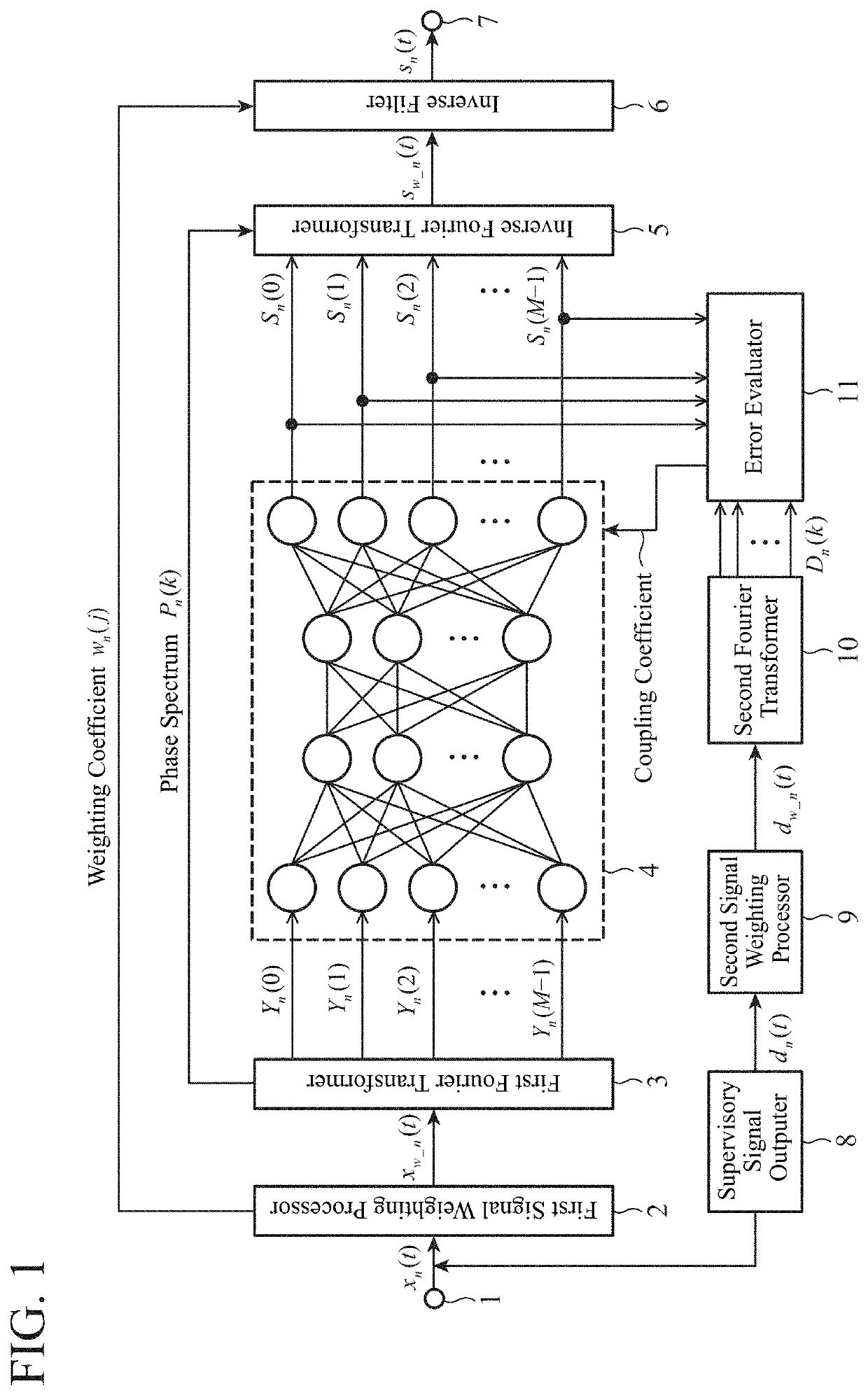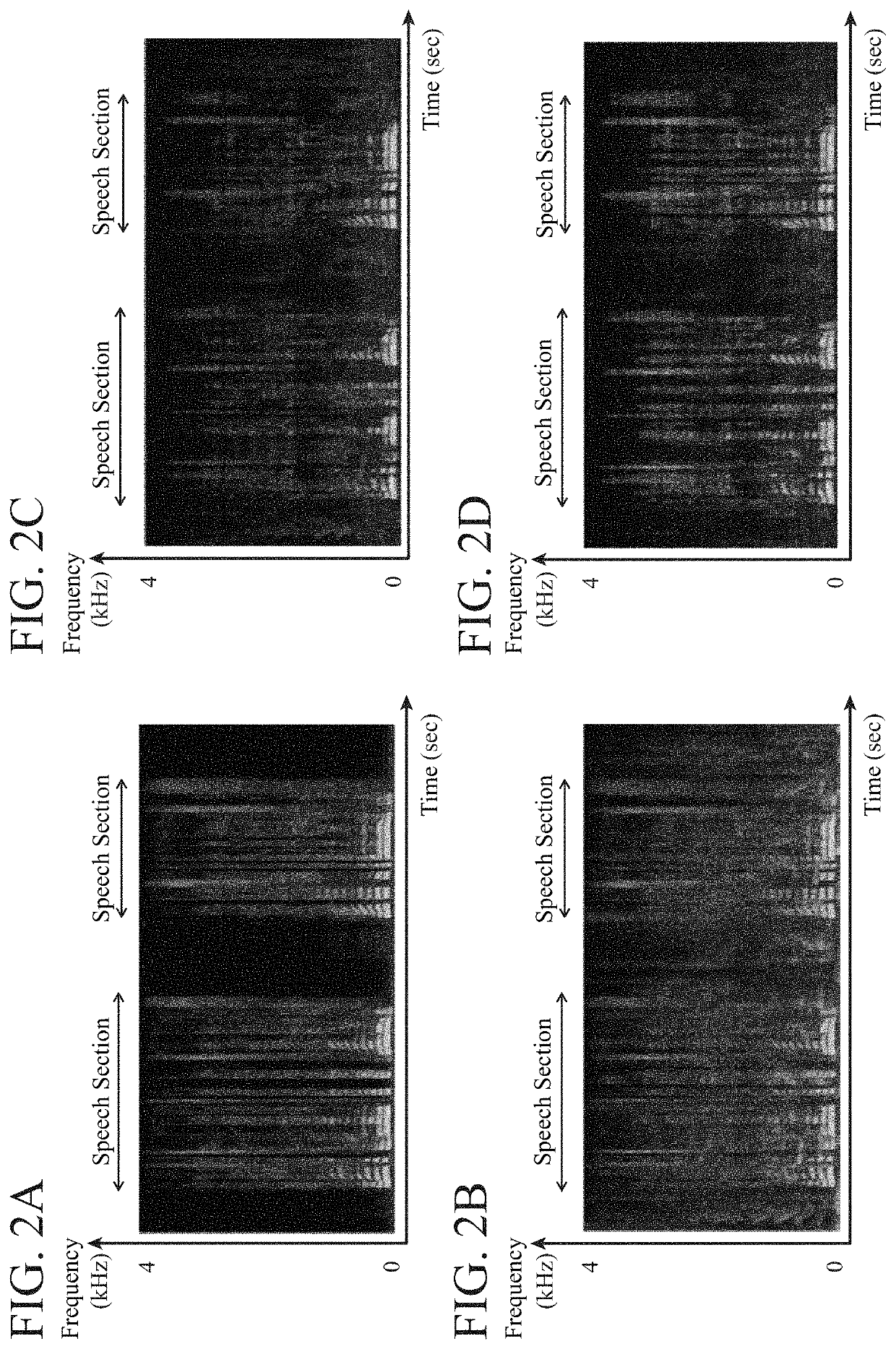Sound signal enhancement device
a sound signal and enhancement device technology, applied in the field of sound signal enhancement devices, can solve the problems of inability to collect a small amount of learning data, large amount of learning data requires a great amount of time and cost, and the learning of a neural network does not work well, so as to achieve the effect of high-quality enhancement of sound signals
- Summary
- Abstract
- Description
- Claims
- Application Information
AI Technical Summary
Benefits of technology
Problems solved by technology
Method used
Image
Examples
embodiment 1
[0020]FIG. 1 is a block diagram illustrating a schematic configuration of a sound signal enhancement device according to Embodiment 1 of the present invention. The sound signal enhancement device illustrated in FIG. 1 includes a signal input part 1, a first signal weighting processor 2, a first Fourier transformer 3, a neural network processor 4, an inverse Fourier transformer 5, an inverse filter 6, a signal output part 7, a supervisory signal outputer 8, a second signal weighting processor 9, a second Fourier transformer 10, and an error evaluator 11.
[0021]An input to the sound signal enhancement device may be a sound signal such as speech sound, music, signal sound, or noise read through a sound transducer like a microphone (not shown) or a vibration sensor (not shown). These sound signals are converted from analog to digital (A / D conversion), sampled at a predetermined sampling frequency (for example, 8 kHz), and divided into frame units (for example, 10 ms) to generate signals ...
embodiment 2
[0081]In the foregoing Embodiment 1, the weighting process of the input signal is performed in the time waveform domain. Alternatively, it is possible to perform the weighting process of an input signal in the frequency domain. This configuration will be described as Embodiment 2.
[0082]FIG. 7 illustrates an internal configuration of a sound signal enhancement device according to the Embodiment 2. In FIG. 7, configurations different from those of the sound signal enhancement device of the Embodiment 1 illustrated in FIG. 1 includes a first signal weighting processor 12, an inverse filter 13, and a second signal weighting processor 14. Other configurations are similar to those of the Embodiment 1, and thus the same symbol is provided to corresponding parts, and descriptions thereof will be omitted.
[0083]The first signal weighting processor 12 is a processing part that receives a power spectrum Yn(k) output from a first Fourier transformer 3, performs in the frequency domain a process ...
embodiment 3
[0090]In the foregoing Embodiments 1 and 2 described above, a power spectrum being a signal in the frequency domain is input to and output from the neural network processor 4. Alternatively, it is possible to input a time waveform signal. This configuration will be described as Embodiment 3.
[0091]FIG. 8 illustrates an internal configuration of a sound signal enhancement device according to the present embodiment. In FIG. 8, an operation of an error evaluator 15 is different from that in FIG. 1. Other configurations are similar to those in FIG. 1, and thus the same symbols are provided to corresponding parts, and descriptions thereof will be omitted.
[0092]A neural network processor 4 receives weighted input signals xw_n(t) output from the first signal weighting processor 2, and outputs, similar to the neural network processor 4 of the foregoing Embodiment 1, enhancement signals sn(t) in which a target signal is enhanced.
[0093]The error evaluator 15 calculates a learning error Et thro...
PUM
 Login to View More
Login to View More Abstract
Description
Claims
Application Information
 Login to View More
Login to View More - R&D
- Intellectual Property
- Life Sciences
- Materials
- Tech Scout
- Unparalleled Data Quality
- Higher Quality Content
- 60% Fewer Hallucinations
Browse by: Latest US Patents, China's latest patents, Technical Efficacy Thesaurus, Application Domain, Technology Topic, Popular Technical Reports.
© 2025 PatSnap. All rights reserved.Legal|Privacy policy|Modern Slavery Act Transparency Statement|Sitemap|About US| Contact US: help@patsnap.com



